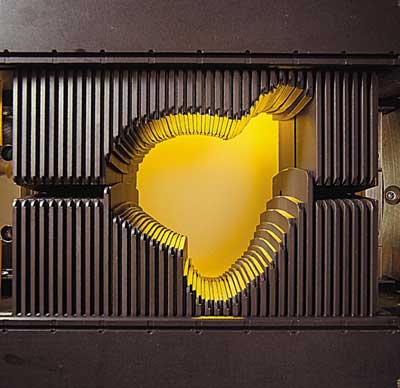It’s Carrie here, doing a guest entry on the cancer crawl.
Today I accompanied Jonathan to radiation, for the first time. Jon’s got a routine down at this point: walk to the Jean Talon metro (getting some exercise in), take metro to Cote-des-Neiges, walk to JGH, enter swank cancer facilities, say hello to everyone he knows there (several people by now), drink a glass of water (or one of three kinds of juices, which is awesome), enter the green room, part hair into ponytails, remove overshirt (if wearing one), wait to be called into radiation room. This is where things get interesting, and rather awe-inspiring.
First off, the radiation room has a giant, 8″ thick steel and lead door, like something out of a Hollywood set for a Cold War drama or a hyper-security conscious “safe room.” This is radiation we’re facing here, so it’s good they have a thick metal door.
We walk through the door into this giant room. This is the biggest room dedicated to a medical procedure for one person that I have ever seen. It is really big. The machine that delivers the radiation is probably 10 feet high, and I would soon learn, it is attached to the wall but it rotates 360 degrees.
Jon has three radiation techs who help get him situated on the table. They all strike me as very young, and I noticed that they all have great hair. They were happy to see me, and filled me in on everything they were doing.
The techs line up Jon in part based upon a set of directions I see on a screen to my right. There are screens everywhere, and I know the screen is about Jon because it includes a photograph of his face. After they afix his mask to the table, there are also lines I see that have been drawn on the mask that will be used to orient him to the machine via 2-3 green lasers that the radiation machine casts from its right and left sides. I am relieved to see the green line lining up well with the right side of his mask, and just before I am told we must leave the room because the treatment is ready to begin, I see that a light is shining on the Jon’s masked chin, in a precise square shape. I think this is the “target area” — something about the lights and lasers feels very reassuring to me. Especially after having read that horrifying New York Times story a few months back about malfunctioning radiation machines, and the mis-targeting of several patients, to very detrimental ends.
The techs and I leave the room. The giant steel door closes behind us and Jon is now locked in, and we are locked out. Two of the techs take their positions at a computer with four screens. The far left screen is divided into four video camera shots of Jonathan lying on the radiation table. The second left screen is the one showing the radiation program running, with the amounts of radiation being given. The third screen shows an X-ray of Jonathan’s neck and face. This is the first screen the techs pay attention to, for it is how they line up the radiation beam to Jon’s physical position. Each day they start him on the table with an X-ray which they then use to calibrate the targeting of the beam based on the position of one of his verterbrae. This, I am told, is how his radiation oncologist told them to line him up. I guess there are other options.
He’s not lining up well today, so one of the techs goes into the radiation room, pulls the sheet under Jon, and returns to the control room. Radiation patients cannot move once they are on the table and afixed in their masks.
Once he’s lined up well and the machine is targeted, the radiation begins. The 10′ machine makes three turns, starting from his left shoulder and going across his body and around the right shoulder to the underside of his skull and then back around two times. While the machine is headed around, on the fourth screen I am able to see the exact shape of the radiation beam, which changes with each movement of the machine across and around Jon’s body. It’s pretty cool and weird. I hadn’t really considered that the beam itself could be manipulated so much. It seemed like there were about 40 different dimensions — or slices might be a better word — through which the radiation beam is directed.
 Posted inCancer
Posted inCancer
Comments are closed.

Thanks for the update Carrie–I hope you both were able to escape via the movie for a bit this evening. Thinking of you… ~Aimee
Oooh – the radiation description was so detailed, I was there and reliving my own experience. Kay was able to accompany me once, but they didn’t let her into “the room”.